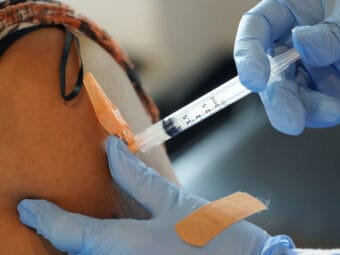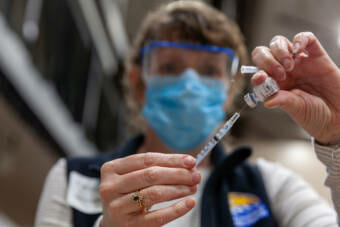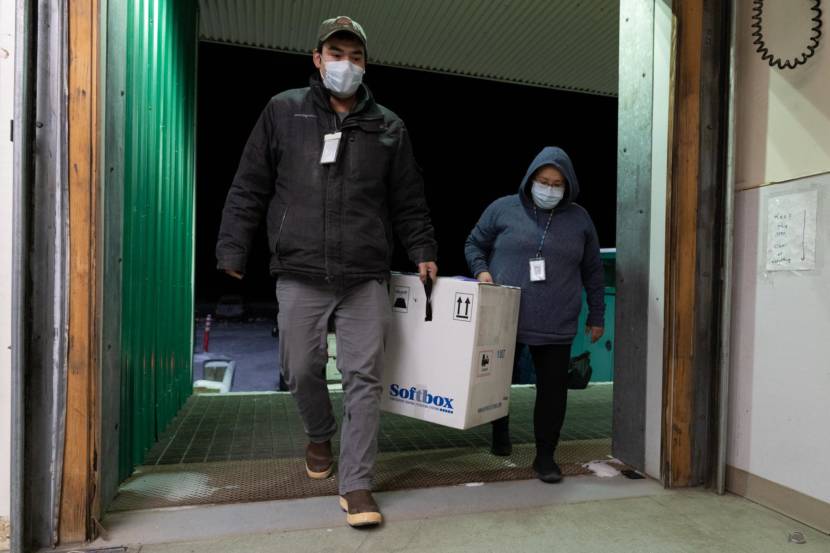
In the tiny Yukon River village of Beaver this year, First Chief Rhonda Pitka has faced dilemma after dilemma.
COVID-19 has forced travel restrictions, and closures of the school and offices. Cultural events like potlatches, funerals and an Indigenous language institute were canceled, too.
“Our people have sacrificed so much to keep each other safe,” Pitka said.
Last month, though, Pitka and her village got a big lift in the form of two vials of the COVID-19 vaccine produced by drug company Moderna. The vials arrived on a chartered plane and held enough doses to vaccinate 10 of Beaver’s 60 residents.
Tribal leaders like Pitka had a say over who would get them.
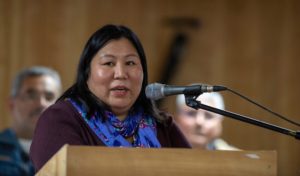
Nine shots were reserved for elders and people with health problems that put them at risk for severe illness. And a final dose was set aside for one of Beaver’s speakers of Gwich’in, the local indigenous language that has just a few hundred speakers left.
“Just having one thing that we had a modicum of control over has really been empowering, to say the least,” said Pitka, 43. “It definitely feels like a big weight off my shoulders, that my elders will still be alive.”
Pandemic diseases like the 1918 flu have repeatedly decimated Native communities in Alaska, and COVID-19 has played out in a confoundingly similar way: Alaska Natives and American Indians account for roughly double the proportion of coronavirus deaths in the state compared to their share of the overall population.
But after a year of pleading for access to COVID-19 testing, treatments and protective equipment, tribal health-care leaders say that a vaccine partnership with the Trump administration has brought hope of reducing those disparities, and a measure of relief amid an unrelenting public health crisis.
Operation Warp Speed, the Trump administration’s vaccine initiative, has treated the nation’s tribes as sovereign governments and set aside special shipments for them, just as it’s designated doses for the Department of Defense, Veterans Health Administration and Bureau of Prisons.
So far, the federal government has distributed more than 35,000 doses to Alaska tribes — on top of the 78,000 doses it’s delivered to Alaska’s state government. And more than 250,000 doses have been dedicated to tribes nationwide through the Indian Health Service.
“It’s something to celebrate,” said Verné Boerner, chief executive of the Alaska Native Health Board. “When you embrace tribes and tribal sovereignty, you can bring so much more to the state.”
The tribal shipments have afforded broad vaccine access for rural and Indigenous Alaskans, contrasting with the state government’s vaccination program in Alaska’s urban and road system communities, which has been marred by problems with computer systems and communication.
While many elderly residents of Anchorage and the Mat-Su endure frustrating waits for vaccine appointments, tribal providers are now expanding the availability of doses beyond senior citizens. (Providers also acknowledge that, in a worrying sign, part of the reason they can offer expanded access is because many of their patients are refusing the vaccine.)
In Nome, Norton Sound Health Corp. began vaccinating teachers two weeks ago. It’s now injecting anyone 50 and older, as well as younger people with two or more “high-risk medical conditions.”
In Southwest Alaska, anyone 16 or older who lives in a village is now eligible for a shot through the regional tribal health organization, Yukon-Kuskokwim Health Corp. And in Anchorage, the tribally-run Southcentral Foundation is offering doses to “customer-owners” 18 and older.
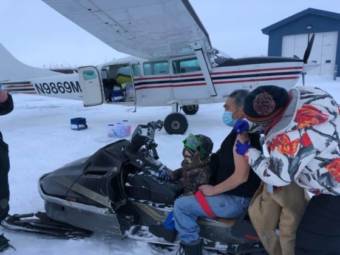
While tribal providers are using their doses to vaccinate both Indigenous and non-Indigenous people, state and Native leaders say there’s a sound legal basis for the separate shipments, given tribes’ longstanding recognized status as sovereign governments.
They also say that the Trump administration’s decision is appropriate from a scientific and medical standpoint. That’s because of the pandemic’s disproportionate impact on Alaska Native people and the dynamics in many rural communities that make the virus difficult to control: crowded multi-generational homes, lack of running water and sewer systems and distance from advanced medical care.
“It’s never been about equal distribution of the vaccine. It’s about equitable distribution,” said Dr. Ellen Hodges, chief of staff at YKHC. “The congregate living settings that exist in most of our villages is a setup for the virus to just spread like wildfire, and there’s no defense against that.”
While the tribal shipments have made a significant impact in Alaska, they weren’t assured until the last minute, according to Dr. Anne Zink, the state’s chief medical officer.
As the Trump administration prepared its vaccine rollout, it gave tribal health programs the option to receive their doses either through the IHS or through the states where they’re located. And it said the size of the shipments would be the same regardless of which option tribes chose, according to Zink.
But after Alaska tribes chose to work with the state, Zink said she learned at the “11th hour” that the Trump administration planned to count the tribal vaccines against Alaska’s shipment — a change that would cost the state and its tribes tens of thousands of doses.
The decision was only reversed after a “robust conversation” between Zink and Gen. Gustave Perna, the head of Operation Warp Speed, plus an evening meeting, Zink said.
Zink said the tribes have been indispensable in distributing doses across the state, given the geographic and logistical challenges entailed with getting the vaccine to Alaska’s rural communities off the road system. Tribal health organizations have harnessed a fleet of chartered bush planes, snowmachines, and even sleds and a water taxi to move doses.
“They just went and figured out what needed to be done — much more efficiently than we could have at the state, and way more efficiently than could have been done at the federal level,” Zink said.
Tribal health-care leaders say they’ve been grateful for their vaccine partnerships with the state and federal governments.
But Bob Onders, administrator of the Alaska Native Medical Center in Anchorage, said he’s withholding judgment until later in the vaccination process, to see if the federal distribution continues at the same level.
He noted that securing the doses, along with supplies of COVID-19 tests and personal protective equipment over the course of the pandemic, has required tribes to engage in “continual advocacy.”
“We’re very early in, and it’s the outcomes that matter, not the intermediate steps,” Onders said. “Seeing tribal health organizations able to prioritize based on their own priorities is a critically important step in that process. And so that, I think, has been a good outcome. But we still have to see how it goes over the next few months.”
Tribes have the authority to make their own decisions about who to prioritize for the first shots, though they’ve largely hewed to federal recommendations of starting with health care personnel, elders and essential workers.
One notable difference that’s emerged nationwide is in tribes’ choices to vaccinate speakers of endangered Indigenous languages. That’s happened in the Cherokee Nation in Oklahoma, as well as in Beaver, the Yukon River village where Pitka is first chief.
Next on Beaver’s vaccination list are school staff, the snowplow driver and the workers who operate the village’s water and power plants, Pitka said.
After a tough year, she said, her village’s experience with the vaccine has provided, finally, a reason for optimism.
“It left me with a lot of hope for this year,” she said. “That things will get better.”

